SUBARU IMPREZA WRX 2004 2.G Owners Manual
Manufacturer: SUBARU, Model Year: 2004, Model line: IMPREZA WRX, Model: SUBARU IMPREZA WRX 2004 2.GPages: 491, PDF Size: 5.93 MB
Page 401 of 491
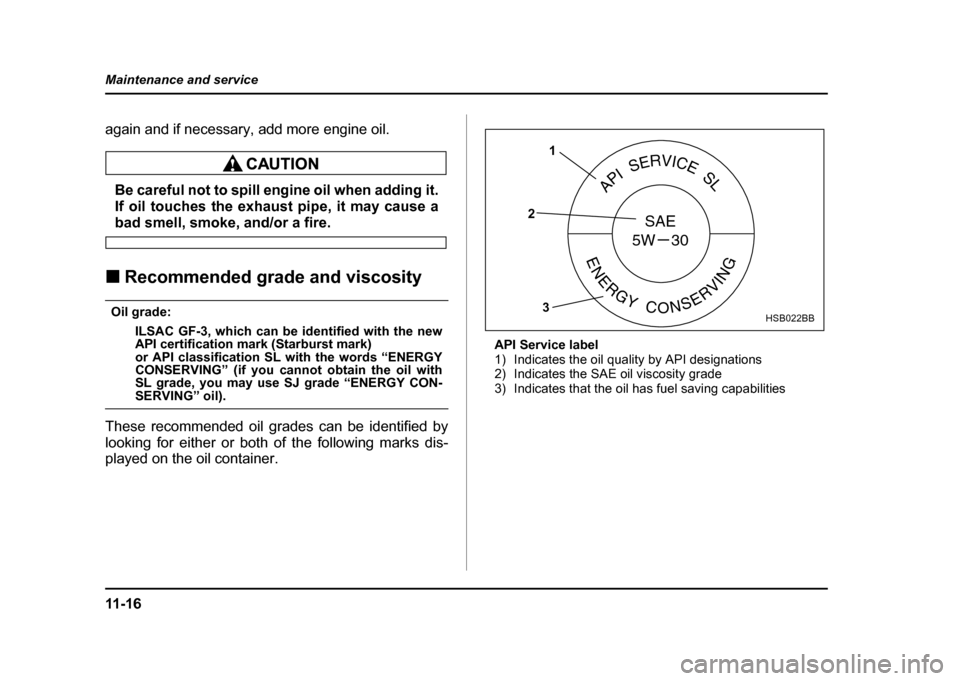
11 - 1 6
Maintenance and service
again and if necessary, add more engine oil.
Be careful not to spill engine oil when adding it.
If oil touches the exhaust pipe, it may cause a
bad smell, smoke, and/or a fire.
! Recommended grade and viscosity
Oil grade:
ILSAC GF-3, which can be identified with the new
API certification mark (Starburst mark)
or API classification SL with the words “ENERGY
CONSERVING” (if you cannot obtain the oil with
SL grade, you may use SJ grade “ENERGY CON-
SERVING” oil).
These recommended oil grades can be identified by
looking for either or both of the following marks dis-
played on the oil container. API Service label
1) Indicates the oil quality by API designations
2) Indicates the SAE oil viscosity grade
3) Indicates that the oil has fuel saving capabilities
APISERVICESL
ENERGYCONSERVING
SAE
5W
30
1
2
3
HSB022BB
Page 402 of 491
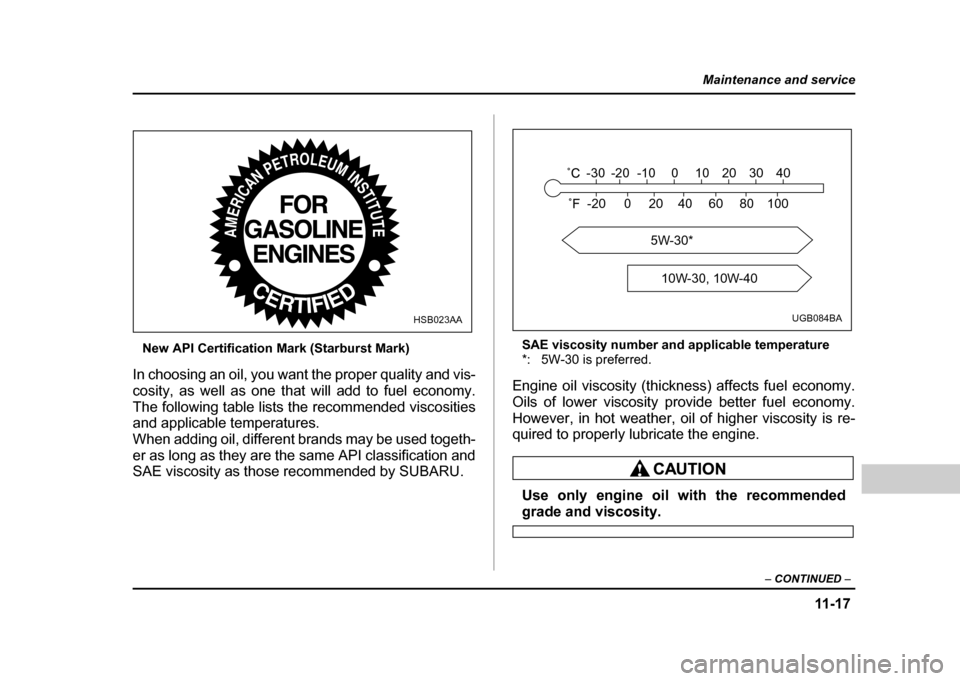
11 -1 7
Maintenance and service
– CONTINUED –
New API Certification Mark (Starburst Mark)
In choosing an oil, you want the proper quality and vis-
cosity, as well as one that will add to fuel economy.
The following table lists the recommended viscosities
and applicable temperatures.
When adding oil, different brands may be used togeth-
er as long as they are the same API classification and
SAE viscosity as those recommended by SUBARU. SAE viscosity number and applicable temperature
*: 5W-30 is preferred.
Engine oil viscosity (thickness) affects fuel economy.
Oils of lower viscosity provide better fuel economy.
However, in hot weather, oil of higher viscosity is re-
quired to properly lubricate the engine.
Use only engine oil with the recommended
grade and viscosity.
AMERICANPETROLEUMINSTITUTE
CERTIFIED
HSB023AA
5W-30*
10W-30, 10W-40
-30 -20 -10 0 10 20 30 40
-20
06 0
20 80 100 40
UGB084BA
Page 403 of 491
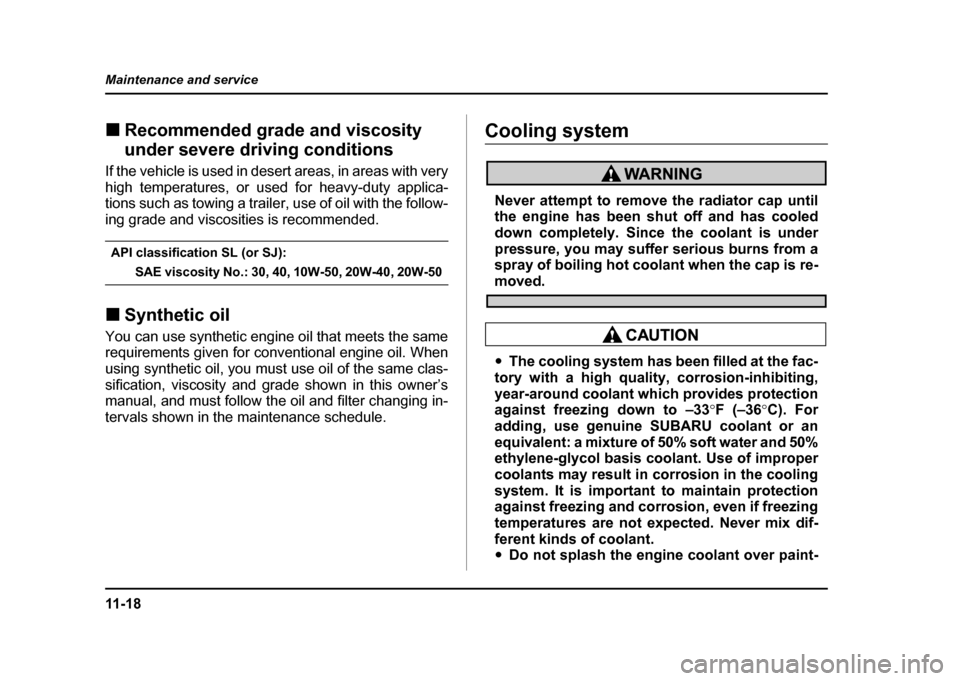
11 - 1 8
Maintenance and service
!
Recommended grade and viscosity
under severe driving conditions
If the vehicle is used in desert areas, in areas with very
high temperatures, or used for heavy-duty applica-
tions such as towing a trailer, use of oil with the follow-
ing grade and viscosities is recommended.
API classification SL (or SJ):
SAE viscosity No.: 30, 40, 10W-50, 20W-40, 20W-50
! Synthetic oil
You can use synthetic engine oil that meets the same
requirements given for conventional engine oil. When
using synthetic oil, you must use oil of the same clas-
sification, viscosity and grade shown in this owner’s
manual, and must follow the oil and filter changing in-
tervals shown in the maintenance schedule.
Cooling system
Never attempt to remove the radiator cap until
the engine has been shut off and has cooled
down completely. Since the coolant is under
pressure, you may suffer serious burns from a
spray of boiling hot coolant when the cap is re-
moved.
" The cooling system has been filled at the fac-
tory with a high quality, corrosion-inhibiting,
year-around coolant which provides protection
against freezing down to –33 °F (–36 °C). For
adding, use genuine SUBARU coolant or an
equivalent: a mixture of 50% soft water and 50%
ethylene-glycol basis coolant. Use of improper
coolants may result in corrosion in the cooling
system. It is important to maintain protection
against freezing and corrosion, even if freezing
temperatures are not expected. Never mix dif-
ferent kinds of coolant. " Do not splash the engine coolant over paint-
Page 404 of 491
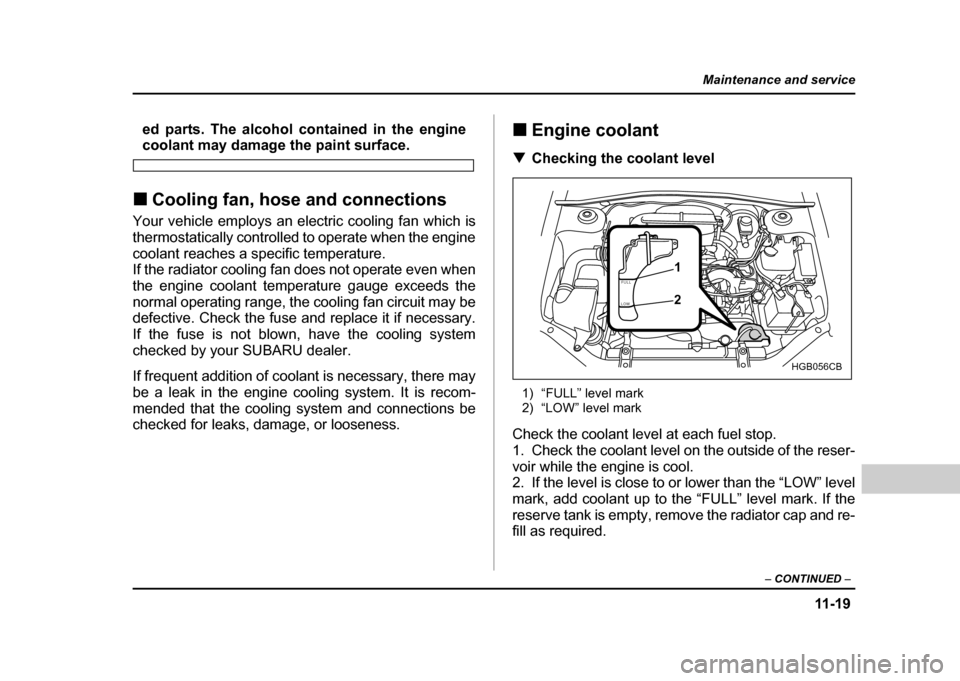
11 -1 9
Maintenance and service
– CONTINUED –
ed parts. The alcohol contained in the enginecoolant may damage the paint surface.
! Cooling fan, hose and connections
Your vehicle employs an electric cooling fan which is
thermostatically controlled to operate when the engine
coolant reaches a specific temperature.
If the radiator cooling fan does not operate even when
the engine coolant temperature gauge exceeds the
normal operating range, the cooling fan circuit may be
defective. Check the fuse and replace it if necessary.
If the fuse is not blown, have the cooling system
checked by your SUBARU dealer.
If frequent addition of coolant is necessary, there may
be a leak in the engine cooling system. It is recom-
mended that the cooling system and connections be
checked for leaks, damage, or looseness. !
Engine coolant
! Checking the coolant level
1) “FULL” level mark
2) “LOW” level mark
Check the coolant level at each fuel stop.
1. Check the coolant level on the outside of the reser-
voir while the engine is cool.
2. If the level is close to or lower than the “LOW” level
mark, add coolant up to the “FULL” level mark. If the
reserve tank is empty, remove the radiator cap and re-
fill as required.
FULL
LOW
HGB056CB
1 2
Page 405 of 491
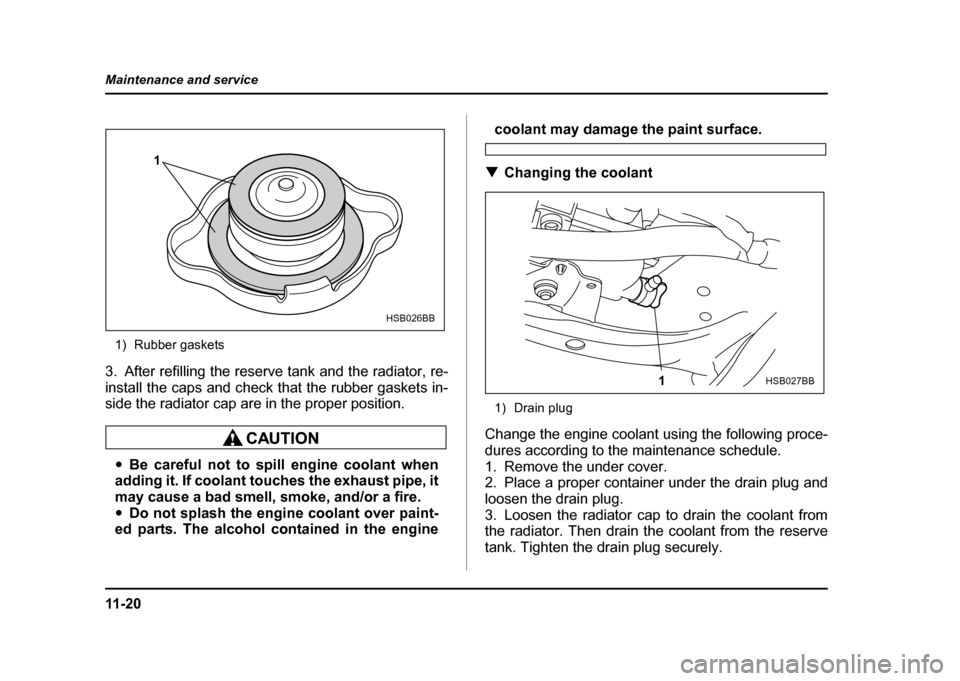
11 - 2 0
Maintenance and service
1) Rubber gaskets
3. After refilling the reserve tank and the radiator, re-
install the caps and check that the rubber gaskets in-
side the radiator cap are in the proper position.
" Be careful not to spill engine coolant when
adding it. If coolant touches the exhaust pipe, it
may cause a bad smell, smoke, and/or a fire." Do not splash the engine coolant over paint-
ed parts. The alcohol contained in the engine
coolant may damage the paint surface.
! Changing the coolant
1) Drain plug
Change the engine coolant using the following proce-
dures according to the maintenance schedule.
1. Remove the under cover.
2. Place a proper container under the drain plug and
loosen the drain plug.
3. Loosen the radiator cap to drain the coolant from
the radiator. Then drain the coolant from the reserve
tank. Tighten the drain plug securely.
1
HSB026BB
1HSB027BB
Page 406 of 491
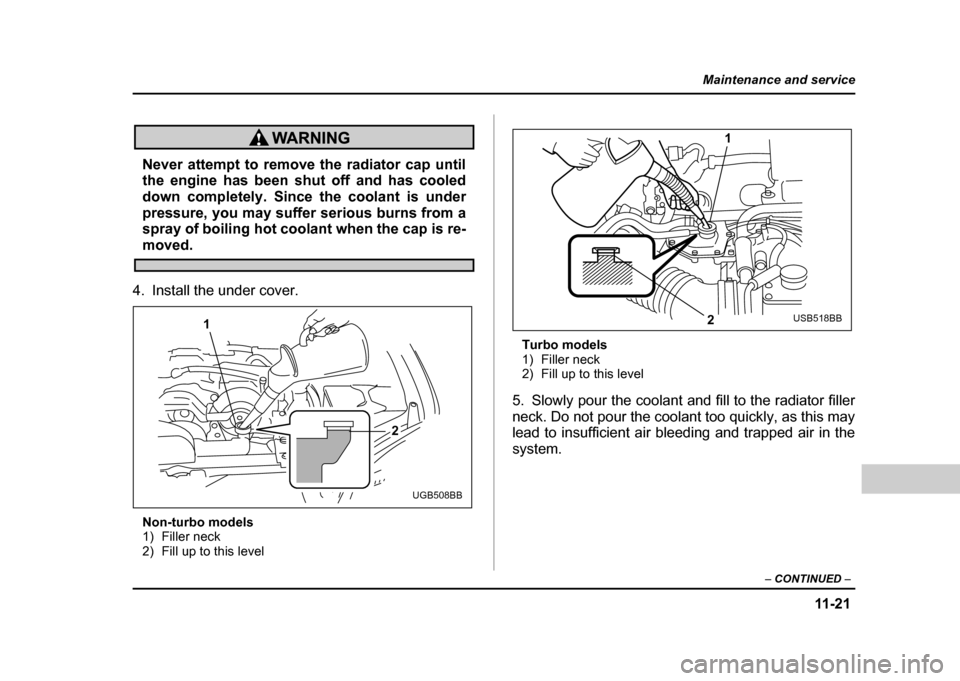
11 -2 1
Maintenance and service
– CONTINUED –
Never attempt to remove the radiator cap until
the engine has been shut off and has cooled
down completely. Since the coolant is under
pressure, you may suffer serious burns from a
spray of boiling hot coolant when the cap is re-
moved.
4. Install the under cover.
Non-turbo models
1) Filler neck
2) Fill up to this level Turbo models
1) Filler neck
2) Fill up to this level
5. Slowly pour the coolant and fill to the radiator filler
neck. Do not pour the coolant too quickly, as this may
lead to insufficient air bleeding and trapped air in the system.
1
2
UGB508BB
1
2
USB518BB
Page 407 of 491
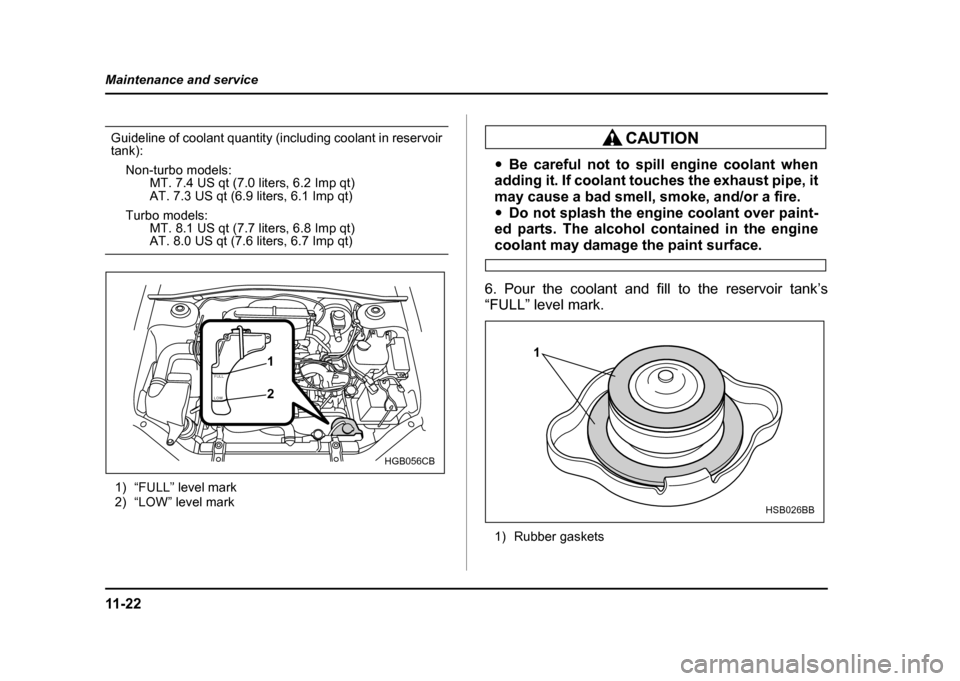
11 - 2 2
Maintenance and service
Guideline of coolant quantity (including coolant in reservoir tank):
Non-turbo models: MT. 7.4 US qt (7.0 liters, 6.2 Imp qt)
AT. 7.3 US qt (6.9 liters, 6.1 Imp qt)
Turbo models: MT. 8.1 US qt (7.7 liters, 6.8 Imp qt)
AT. 8.0 US qt (7.6 liters, 6.7 Imp qt)
1) “FULL” level mark
2) “LOW” level mark
" Be careful not to spill engine coolant when
adding it. If coolant touches the exhaust pipe, it
may cause a bad smell, smoke, and/or a fire." Do not splash the engine coolant over paint-
ed parts. The alcohol contained in the engine
coolant may damage the paint surface.
6. Pour the coolant and fill to the reservoir tank’s
“FULL” level mark.
1) Rubber gaskets
FULL
LOW
HGB056CB
1 21
HSB026BB
Page 408 of 491
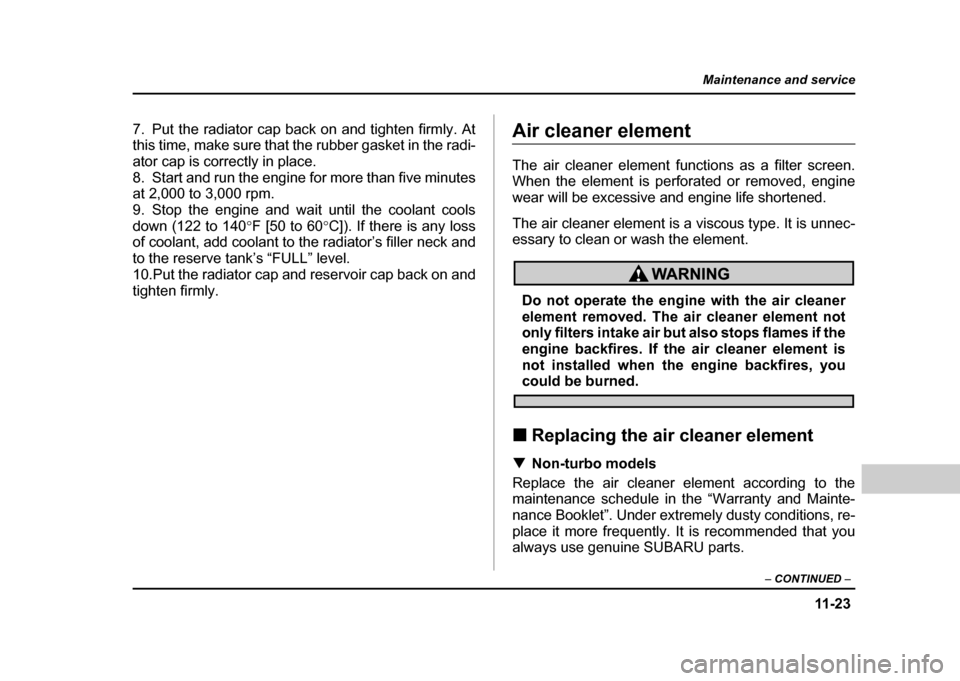
11 -2 3
Maintenance and service
– CONTINUED –
7. Put the radiator cap back on and tighten firmly. At
this time, make sure that the rubber gasket in the radi-
ator cap is correctly in place.
8. Start and run the engine for more than five minutes
at 2,000 to 3,000 rpm.
9. Stop the engine and wait until the coolant cools
down (122 to 140 °F [50 to 60 °C]). If there is any loss
of coolant, add coolant to the radiator’s filler neck and
to the reserve tank’s “FULL” level.
10.Put the radiator cap and reservoir cap back on and
tighten firmly.Air cleaner element
The air cleaner element functions as a filter screen.
When the element is perforated or removed, engine
wear will be excessive and engine life shortened.
The air cleaner element is a viscous type. It is unnec-
essary to clean or wash the element.
Do not operate the engine with the air cleaner
element removed. The air cleaner element not
only filters intake air but also stops flames if the
engine backfires. If the air cleaner element is
not installed when the engine backfires, you
could be burned.
! Replacing the air cleaner element
! Non-turbo models
Replace the air cleaner element according to the
maintenance schedule in the “Warranty and Mainte-
nance Booklet”. Under extremely dusty conditions, re-
place it more frequently. It is recommended that you
always use genuine SUBARU parts.
Page 409 of 491
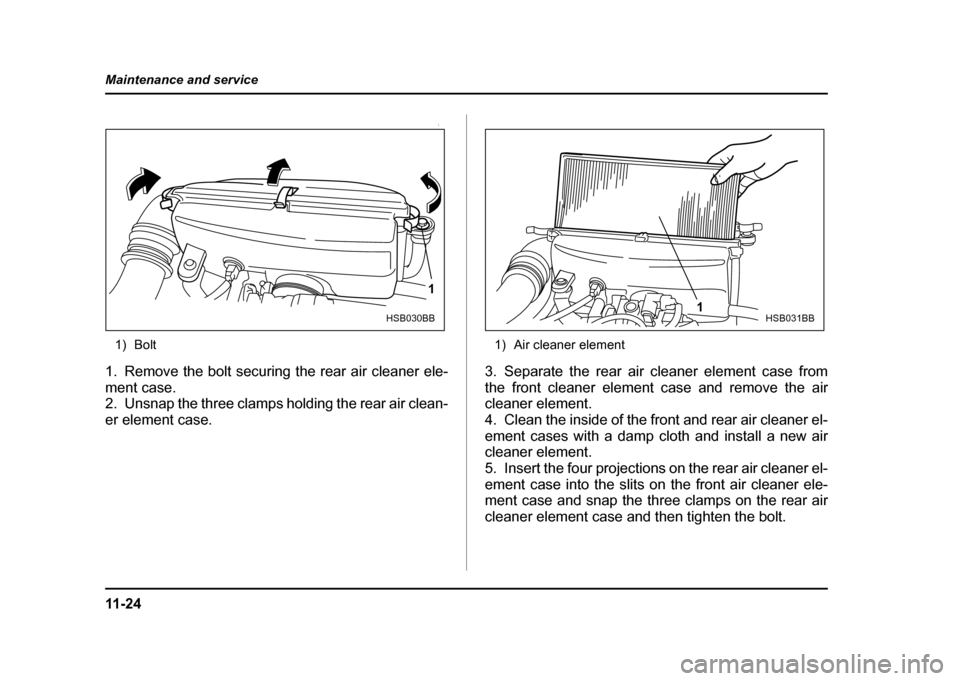
11 - 2 4
Maintenance and service
0
1) Bolt
1. Remove the bolt securing the rear air cleaner ele- ment case.
2. Unsnap the three clamps holding the rear air clean-
er element case. 1) Air cleaner element
3. Separate the rear air cleaner element case from
the front cleaner element case and remove the air
cleaner element.
4. Clean the inside of the front and rear air cleaner el-
ement cases with a damp cloth and install a new air
cleaner element.
5. Insert the four projections on the rear air cleaner el-
ement case into the slits on the front air cleaner ele-
ment case and snap the three clamps on the rear air
cleaner element case and then tighten the bolt.
1
HSB030BB1HSB031BB
Page 410 of 491
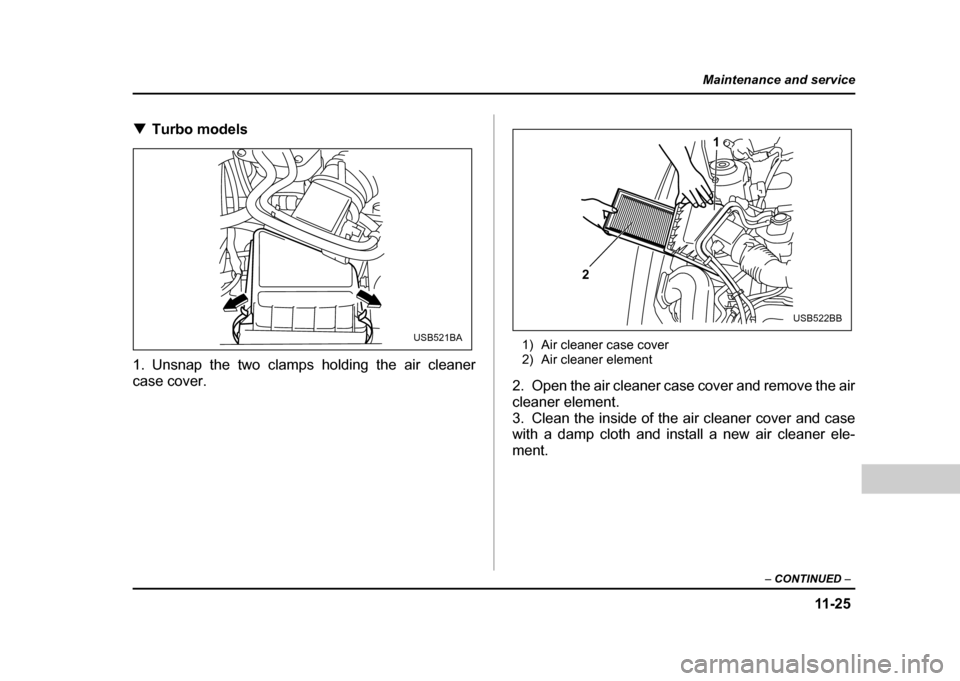
11 -2 5
Maintenance and service
– CONTINUED –
!Turbo models
1. Unsnap the two clamps holding the air cleaner case cover. 1) Air cleaner case cover
2) Air cleaner element
2. Open the air cleaner case cover and remove the air
cleaner element.
3. Clean the inside of the air cleaner cover and case
with a damp cloth and install a new air cleaner ele-ment.
USB521BA
2 1
USB522BB